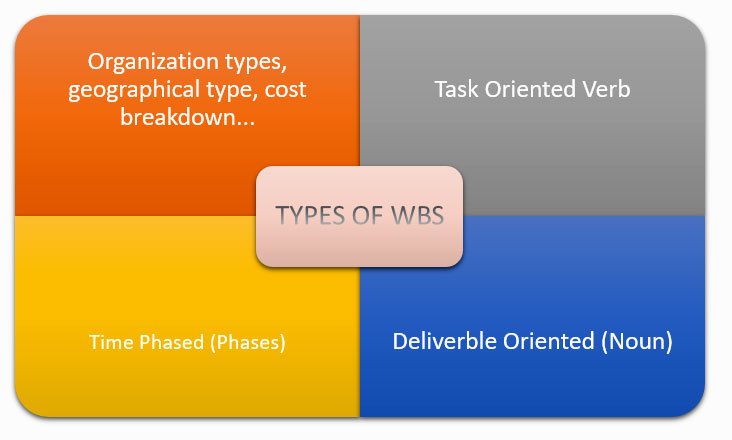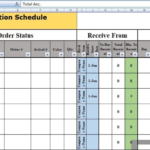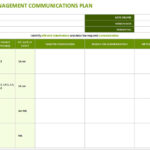The Work Breakdown Structure (WBS) is the information about the amount and type of work the project comprehends.
The Project Managers often use this planning tool to plan and develop a project timeline and estimate resources needed, and the cost required to fulfill the project.
Check out Project Quality Control Plan Template as a Related Template.
Work Breakdown Structure in Project Management
The Work breakdown structure template comes in different layouts and structures, you can choose one according to your need and type of the project you are working on.
For, instance some projects are big and complicated in nature, so they require a different more detailed layout of WBS.
And in the same way, some projects are of a smaller type and do not require detailed planning for them we can use a general and simple Work breakdown structure tool.
In this article, we will discuss how you create a work breakdown structure. We also will see what the key benefit of a work breakdown is structure.
In short, this article will aid you to learn everything you need to know about work breakdown structures.
We will discuss the diverse types, advantages, and steps to make this template. If you are intending to begin a project in your company, you would gain a lot of help from learning all this information here. First, let us have a look at how WBS works.
Related Content: Critical Path Method Template
Work Breakdown Structure (WBS) Template in Excel is a valuable tool used in project management to efficiently organize and plan complex projects. This structured document provides a hierarchical breakdown of tasks, activities, and deliverables required to complete the project successfully.
The WBS template in Excel offers a user-friendly and customizable platform to create, track, and manage project tasks, making it a popular choice among project managers and teams.
How Does a WBS Template Work?
A work breakdown structure or WBS is an indispensable and vital project management and planning tool. This tool is frequently employed to divide the work of the team into portions that are simpler to handle.
- The work breakdown structure consists of the whole team in the beginning by creating highly essential and valuable deliverables.
- Therefore, the next stage is splitting those deliverables into tinier parts in more manageable sizes.
- These small ones are then broken down more up until a single team member is allocated.
- In the very last part, all the members got their specific tasks broken into pieces to manage effectively.
Work Breakdown Structure Diagram
A WBS diagram articulates the project opportunity and explains the tasks in simple explicit terms. The diagram begins with a single box on the crown to symbolize the whole project.

Then the project is categorized into main disparate components, with related activities with related information under them. Normally, the higher parts are for deliverables and the lower one is for the events that generate and establish the deliverables.
Related Template: Project Scope Statement Template in Excel
Types of Work Breakdown Structure?
The Work Breakdown Structures template has several types according to the type and size of the project. As the WBS is the work plan and a schematic diagram of the project plan and tasks allocated it can be of various types and formats. Let us see some of the templates which can be chosen for a project in your company.

1. Verb-Oriented Work Breakdown Structure
This WBS template time is mainly based on actions. This type focuses on the main actions that need to be done to make the project run smoothly.
2. Element-Based Work Breakdown Structure
This is an element-focused kind of WBS. In this type, the main center point under consideration is the practical and operational elements of the project.
3. Time-Oriented Work Breakdown Structure
This is a time-based sort of WBS which is often used for projects which are time-consuming. This category of WBS is divided into general phases instead of smaller duties and activities.
4. Cost WBS and Profit Center WBS
These 2 kinds focus on the finances of the project. The main components under consideration are the costs or profits of the whole project.
So, by now we have discussed a few types of WBS which are utilized and applied by companies to establish their projects more effectively. Now let us have a look at the distinct advantages of applying a work breakdown structure to your business requirements of the Project.
What are the Advantages of Using a Work Breakdown Structure?
There are various types of benefits of using a work breakdown structure. This tool facilitates the managers to efficiently manage and run a project in an association. Change management often is a time-consuming, lengthy, and hectic job. Furthermore, the new projects need more attention and time than the ongoing ones.
Here is a list of some important benefits of using a work breakdown structure Template:
- The WBS would make and bring out comprehensive steps
- This tool might also be used as a helping tool for creating Timetable and Financial Plan
- It also promotes dedication and establishes a sense of responsibility in project team members
- The WBS stimulates clarity will result in enhancing efficiency
- The Work Breakdown Structure is the ideal tool for tracing and tracking Development
These are the most valuable advantages of applying a WBS tool prior to placing a project into action. Now let’s see some examples of WBS.
Resource Breakdown Structure
The resource breakdown structure (RBS) is an essential tool, especially for projects of manufacturing company types. It is classified and well-graded steps about the tasks and strategies of the project to run and complete the project successfully.
This tool is exceptionally useful and valuable for the kind of projects which include a complex variety of different resources.
Consequently, the resource breakdown structures permit managers to have a bird’s eye on all the resources needed. This tool also helps in understanding and pinpointing which resource capacity is a need and at which point.
Construction Project Work Breakdown Structure Template
A well-planned construction work breakdown structure is the basis of a well-managed and well-built construction project schedule. Mostly the project planners start working on their construction plan by creating a good Work Breakdown Structure.
For example, when starting or building a new tower or a bridge a strong foundation is necessary. In the same way, solid ground and proper planning are needed to start a construction project. So, a work breakdown structure (WBS) should set up a compact organization for your construction project plan.
Although every construction project is unique, and different in its own way the best practice for all categories of construction projects is WBS.
Conclusion
Hence, the Work Breakdown Structure characterizes all the work necessary to achieve this project. So, whenever companies start a project, the most essential thing to keep in mind is Work Breakdown Structure to carry it out smoothly.
WBS template in Excel typically consists of multiple columns, including task names, task descriptions, assigned team members, start and end dates, project status, and dependencies.
Each task is represented as a separate row, and the indentation level denotes the task’s position in the hierarchy. The top-level tasks represent major project phases, while subsequent levels further break down these phases into more manageable and specific sub-tasks.





